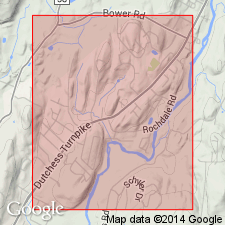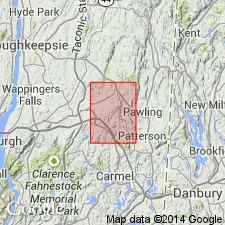
- Usage in publication:
-
- Rochdale group
- Modifications:
-
- Named
- Dominant lithology:
-
- Limestone
- AAPG geologic province:
-
- New England province
Summary:
The Rochdale group with its unique set of numerous fossils, yet only very partially described, is the one which in previous papers has been called the "Calciferous," because it was considered closely related to it. The Rochdale fauna is separated from the "Calciferous" and the "Chazy" because these units are under review. The fauna is most richly preserved at Rochdale, Dutchess Co., NY. The unit conformably underlies the Trenton limestone and overlies the Potsdam or Upper Cambrian. The Rochdale is considered of Early Ordovician age.
Source: GNU records (USGS DDS-6; Reston GNULEX).

- Usage in publication:
-
- Rochdale Limestone*
- Modifications:
-
- Revised
- AAPG geologic province:
-
- New England province
Summary:
Rochdale Limestone is here assigned to the Wappinger Group. It overlies the Halcyon Lake Formation of the Wappinger.
Source: GNU records (USGS DDS-6; Reston GNULEX).
For more information, please contact Nancy Stamm, Geologic Names Committee Secretary.
Asterisk (*) indicates published by U.S. Geological Survey authors.
"No current usage" (†) implies that a name has been abandoned or has fallen into disuse. Former usage and, if known, replacement name given in parentheses ( ).
Slash (/) indicates name conflicts with nomenclatural guidelines (CSN, 1933; ACSN, 1961, 1970; NACSN, 1983, 2005, 2021). May be explained within brackets ([ ]).

